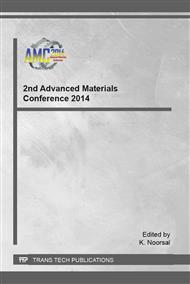p.126
p.131
p.136
p.141
p.146
p.151
p.156
p.161
p.166
Physical and Mechanical Properties of Warm Compacted Carbon-Copper Composite by Different Powder Formulation
Abstract:
Carbon(C)/Copper(Cu) Composites based materials were developed by associating both pressure and heat to the mixture of the powder. Three samples of different formulations were prepared by the powder metallurgy route in which the C-Cu powder were mixed with E-poxy Resin in a tubular mixer, pre-compacted using an automated hydraulic press machine, warm compacted using a warm compaction machine and finally post baked in oven. Each sample was subjected to density, hardness, transverse rupture strength and resistivity tests. The microstructures of the sample were observed under the scanning electron microscope. Test results of the developed samples show that sample C produced the highest physical, mechanical and electrical properties. However, the samples developed had lower physical, mechanical and electrical properties as compared with the commercial sample. This phenomenon was taught to be due to high porosity and insolubility of carbon and copper in the sample developed. Thus, father study will be done based on sample C formulation.
Info:
Periodical:
Pages:
146-150
Citation:
Online since:
January 2016
Price:
Сopyright:
© 2016 Trans Tech Publications Ltd. All Rights Reserved
Share:
Citation:


